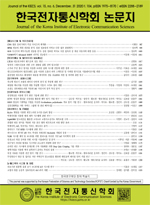BPSK 변조의 최대 전송률 분석
Analysis of Achievable Data Rate under BPSK Modulation: CIS NOMA Perspective
- 한국전자통신학회
- 한국전자통신학회 논문지
- 제15권 제6호
-
2020.12995 - 1001 (7 pages)
-
DOI : 10.13067/JKIECS.2020.15.6.995
- 25

본 논문은 연속 가우시안 입력 변조를 사용하는 대부분의 기존 NOMA 설계와는 대조적으로, BPSK 변조하에서 상관 정보원의 NOMA에 대한 최대 전송률을 분석한다. 먼저, BPSK 변조와 상관 정보원의 NOMA에 대한 최대 전송률의 폐쇄형 표현식을 유도한다. 다음, 수치적 결과를 통해, 강 채널 사용자에 대해서는, 독립 정보원의 최대 전송률과 비교하여, 상관 정보원의 최대 전송률이 감소하는 것을 보여준다. 또한, 약 채널 사용자에 대해서는, 독립 정보원의 최대 전송률과 비교하여, 상관 정보원의 최대 전송률이 증가하는 것을 입증한다. 추가로, 수신 신호와 사용자 간 간섭의 확률 분포 함수의 심도 있는 분석을 통해 이론적 결과를 입증한다.
This paper investigates the achievable data rate for non-orthogonal multiple access(NOMA) with correlated information sources(CIS), under the binary phase shift keying(BPSK) modulation, in contrast to most of the existing NOMA designs using continuous Gaussian input modulations. First, the closed-form expression for the achievable data rate of NOMA with CIS and BPSK is derived, for both users. Then it is shown by numerical results that for the stronger channel user, the achievable data rate of CIS reduces, compared with that of independent information sources( IIS). We also demonstrate that for the weaker channel user, the achievable data rate of CIS increases, compared with that of IIS. In addition, the intensive analyses of the probability density function(PDF) of the observation and the inter-user interferennce(IUI) are provided to verify our theoretical results.
Ⅰ. Introduction
Ⅱ. System and Channel Model
Ⅲ. Derivation of Achievable Data Rate
Ⅳ. Results and Discussions
Ⅴ. Conclusion
References
(0)
(0)